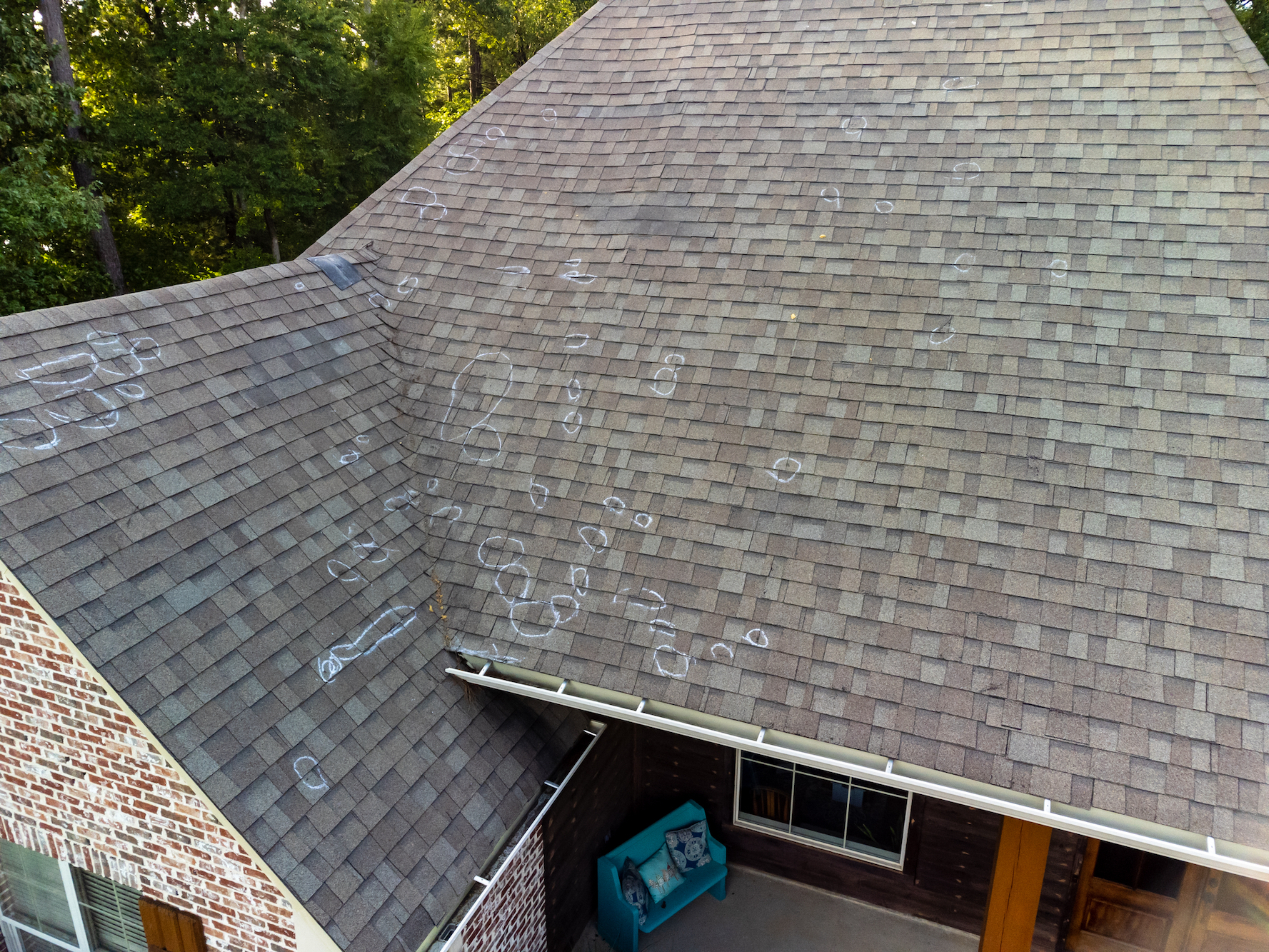
When spring arrives, so does a burst of color, fragrance, and warmth. But for many homeowners, it also signals the start of a less welcomed seasonal phenomenon: pollen. As trees, flowers, and grasses begin to bloom, they release pollen into the air, coating nearly everything in a fine yellow dust.
While you may associate pollen with allergies or cleaning your car, have you considered how this seasonal nuisance might be affecting your roof? The truth is, pollen buildup can disrupt your roof’s water flow, leading to potential damage if not addressed.
Let’s explore the ways in which pollen can interfere with your roof’s drainage system, and what steps you can take to prevent costly damage.
How Does Pollen Affect the Drainage System on a Roof?
Roofs are designed to handle water runoff, especially when it rains heavily. However, roofs are not impervious to the effects of environmental elements, and seasonal changes can introduce new challenges. One of the most overlooked culprits that can compromise the efficiency of your roof’s drainage system is pollen.
During peak pollen season, the air becomes saturated with tiny, airborne particles. As these particles settle, they accumulate on roof surfaces, particularly on sloped or flat roofs that have areas prone to trapping debris. Pollen, being lightweight yet sticky, can form a layer of buildup that obstructs the natural flow of water.
While pollen itself doesn’t have the mass of other debris like leaves or twigs, its sheer volume and stickiness make it particularly problematic for drainage systems. Pollen can collect in areas that are more prone to debris, such as gutters, downspouts, and roof valleys. Over time, this buildup can prevent rainwater from flowing freely into the gutters and downspouts, leading to clogs or overflow.
What Happens When Pollen Clogs Roof Water Channels?
When pollen begins to accumulate in your roof’s drainage system, it doesn’t take long for problems to arise. As mentioned, pollen is sticky, meaning it has a tendency to adhere to surfaces like gutters and downspouts. Even though the particles themselves are small, they can quickly accumulate in large quantities during pollen season, leading to clogging.
The clogs don’t just cause water to pool on the roof; they also disrupt the normal flow of rainwater, leading to a variety of problems:
- Water Stagnation: When water cannot flow through the gutters properly, it can pool on the roof or in other areas. This stagnant water can lead to mold growth, which is both unsightly and damaging to the structure of your home. Left unchecked, mold can infiltrate the roof, the attic, and even the walls, potentially leading to expensive repairs.
- Ice Dams: In some cases, especially when combined with the cold weather of early spring mornings, clogged gutters can lead to ice dams. As snow melts, water backs up and refreezes at the edges of the roof, creating dams that prevent further water from draining properly. This is a serious issue that can lead to leaks inside your home and compromise the integrity of the roof itself.
- Gutter Overflow: When gutters and downspouts become clogged with pollen and other debris, the result can be overflow. Instead of water draining safely away from your home, it pours over the edges of the gutters and falls directly against the foundation. This leads to erosion around the base of your home, which can weaken your foundation and cause cracks over time.
- Structural Weakness: The weight of water that builds up in gutters and along rooflines due to pollen blockage can eventually cause structural damage. Gutters may sag or even detach from the roof, leaving your home vulnerable to water damage during the next rainstorm.
Why Do Roofs Experience Water Overflow During Pollen Season?
The arrival of pollen coincides with a significant increase in rainfall in many areas, particularly during spring. So, why do roofs experience more water overflow during this season, and why is pollen the hidden contributor?
- Increased Rainfall: Spring is a time of fluctuating weather patterns, and in many regions, this season brings heavier rains. The combination of pollen buildup and increased rainfall puts extra pressure on roof drainage systems. When pollen accumulates in gutters, downspouts, or along roof edges, even the slightest rainfall can overwhelm the system and cause overflow.
- Clogged Gutters & Downspouts: The most common source of roof water overflow during pollen season is clogged gutters and downspouts. As pollen mixes with rainwater, it can form a dense, sticky paste that clogs gutters and prevents water from flowing through downspouts. If these channels become completely blocked, the result is overflow that spills over the edges of your roof and potentially damages the foundation.
- Leaf and Debris Build-Up: While pollen itself can be problematic, it often mixes with other types of debris, such as leaves, twigs, and dirt, which settle on the roof. This can exacerbate the issue of clogs, especially in areas of the roof with little slope or natural drainage. As debris piles up, it traps more pollen, and the process snowballs, eventually leading to serious water flow disruptions.
Can Seasonal Pollen Increase the Risk of Roof Water Damage?
While a single instance of pollen buildup may not cause immediate damage to your roof, the long-term effects can be far-reaching. If left unchecked, seasonal pollen can contribute to a series of issues that increase the risk of roof water damage, including:
- Water Infiltration: Prolonged water stagnation on the roof due to clogged gutters can increase the likelihood of water infiltrating through the roof material. Over time, this water can seep into the underlying layers of the roof, potentially causing leaks and structural damage. If your home has a flat roof or low-pitched roof, the risk of water pooling is even greater.
- Wood Rot: Moisture accumulation on your roof can promote the growth of fungi that cause wood rot. This can damage roofing materials and even impact the structural components of your home. Once rot sets in, it can quickly spread, weakening the roof and creating a hazardous living environment.
- Foundation Damage: As mentioned earlier, water that overflows from gutters and downspouts due to pollen clogs can pool around the foundation of your home. Over time, this water can seep into the foundation, causing cracks and compromising the integrity of the entire structure.
- Mold and Mildew: Standing water caused by clogged gutters can provide the perfect breeding ground for mold and mildew. This can lead to health issues for residents, especially those with allergies or respiratory conditions. Mold can also damage roofing materials, insulation, and the interior of your home.
Preventing Pollen-Related Roof Water Issues
Fortunately, there are several steps you can take to prevent pollen buildup from affecting your roof’s water flow:
- Regular Roof Inspections: Schedule roof inspections before and during pollen season to check for signs of clogging or water buildup. A professional roofer can clean out gutters and downspouts, ensuring water flows freely.
- Gutter Guards: Installing gutter guards can help prevent pollen and other debris from accumulating in gutters. This can significantly reduce the risk of clogs and water overflow.
- Frequent Cleaning: If you live in an area with significant pollen accumulation, consider cleaning your roof and gutters more frequently during the spring. This will help remove any debris and ensure water flows smoothly through the system.
- Roof Maintenance: Keeping your roof in good condition with regular maintenance can also help reduce the risk of water damage. This includes checking for leaks, missing shingles, or damaged flashing.
While pollen might seem like a harmless springtime nuisance, its effects on your roof’s drainage system can be more serious than you might think. By causing clogs and obstructing the free flow of water, pollen can lead to a host of water-related problems, including overflow, leaks, and long-term structural damage.
Regular roof maintenance, inspections, and cleaning are essential to keeping your roof in top condition and protecting your home from water damage. By taking these steps, you can ensure that your roof is ready to handle not only the spring rains but also the pollen season that comes with it.
Protect Your Home with Eason Roofing’s Expert Services
At Eason Roofing, we understand the importance of a well-maintained roof, especially when seasonal challenges like pollen buildup threaten your home’s integrity. Our team of experienced roofing professionals offers comprehensive roof inspections, cleaning, and maintenance services designed to protect your home from water damage caused by clogged gutters and drainage systems. We take pride in providing personalized, reliable solutions to ensure your roof remains in optimal condition year-round.
With Eason Roofing, you can count on:
- Thorough Inspections: We conduct detailed inspections to assess any potential damage caused by pollen, debris, or other seasonal factors, ensuring your roof stays functional throughout the year.
- Expert Cleaning and Maintenance: Our team will clear your gutters, downspouts, and roof valleys to prevent blockages, ensuring proper water flow and avoiding the risk of water damage, mold, or leaks.
- Long-Term Protection: With our preventative roof maintenance plans, you can extend the life of your roof, saving you money on costly repairs down the road.
Don’t wait for water damage to compromise your home—reach out to Eason Roofing today to schedule a roof inspection and take the first step in safeguarding your property against seasonal threats!





